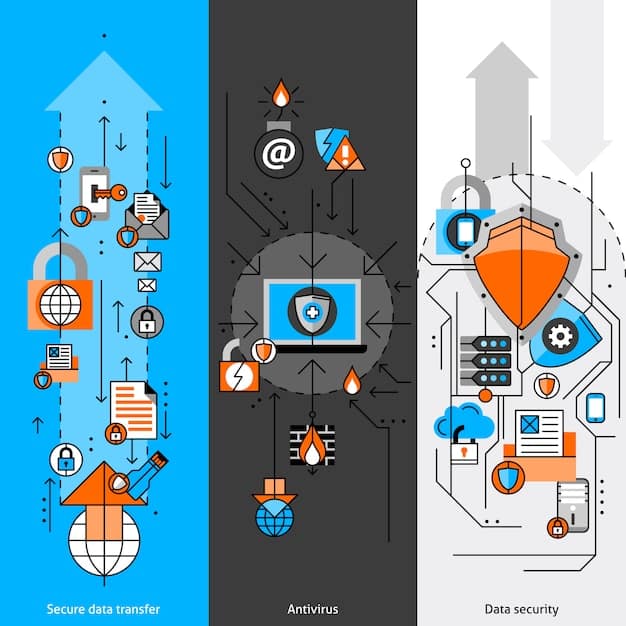Cybersecurity Breaches Surge: New Report Shows 18% Increase

Cybersecurity breaches have alarmingly increased by 18% in the last quarter, according to a new report, highlighting the escalating threats businesses and individuals face in safeguarding their digital assets and sensitive information.
The digital landscape is constantly evolving, and with it, so are the threats lurking in the shadows. A new report reveals a concerning trend: cybersecurity breaches have surged by a significant 18% in the last quarter, raising alarms across industries and prompting calls for enhanced security measures.
New Report Reveals 18% Increase in Cybersecurity Breaches
The latest data paints a stark picture of the current cybersecurity climate. As businesses become increasingly reliant on technology, they also become more vulnerable to sophisticated cyberattacks. This report serves as a wake-up call, urging organizations to prioritize cybersecurity and implement robust defenses.
Understanding the scope of the problem is crucial. The 18% increase represents a significant jump compared to previous quarters, indicating a potential shift in the tactics and effectiveness of cybercriminals. Key findings from the report shed light on the types of breaches, the industries most affected, and the potential consequences for businesses and individuals.

Key Findings from the Cybersecurity Breach Report
- Ransomware Attacks on the Rise: The report highlights a surge in ransomware attacks, where cybercriminals encrypt critical data and demand a ransom for its release.
- Phishing Remains a Persistent Threat: Despite increased awareness, phishing attacks continue to be a successful method for gaining unauthorized access to systems and data.
- IoT Devices as Weak Points: The proliferation of Internet of Things (IoT) devices has created new vulnerabilities, as many of these devices lack adequate security measures.
- Supply Chain Vulnerabilities: Cybercriminals are increasingly targeting organizations through their supply chains, exploiting vulnerabilities in third-party software and services.
In conclusion, the significant increase in cybersecurity breaches underscores the growing need for proactive security measures. Understanding the report’s key findings allows organizations to better prepare for and protect themselves against evolving cyber threats.
Industries Most Affected by Cybersecurity Breaches
While cybersecurity breaches can affect organizations across all sectors, some industries are particularly vulnerable due to the nature of their operations and the type of data they handle. This section delves into the industries that have experienced the most significant impact from the recent surge in cybersecurity incidents.
Healthcare, finance, and retail are consistently among the most targeted industries. Healthcare organizations possess sensitive patient data, making them attractive targets for cybercriminals seeking to steal and sell personal health information (PHI). Financial institutions handle vast amounts of money and financial data, which can be lucrative for attackers. Retailers process credit card information and other customer data, making them susceptible to large-scale data breaches.
Specific Examples of Industry Vulnerabilities
- Healthcare: Outdated systems, a lack of cybersecurity training for staff, and the increasing use of connected medical devices create vulnerabilities in the healthcare sector.
- Finance: Sophisticated phishing attacks targeting employees, vulnerabilities in banking applications, and the reliance on third-party vendors are common challenges for financial institutions.
- Retail: E-commerce platforms, point-of-sale (POS) systems, and customer loyalty programs are all potential entry points for cybercriminals targeting retailers.

Addressing these industry-specific vulnerabilities requires a tailored approach to cybersecurity. Organizations must invest in advanced security technologies, implement robust security policies, and provide ongoing training to employees to raise awareness and prevent attacks. By understanding the unique challenges faced by different industries, businesses can better protect themselves and their customers from the growing threat of cybersecurity breaches.
The Cost of Cybersecurity Breaches: Financial and Reputational Damage
The consequences of a cybersecurity breach can be devastating, extending far beyond immediate financial losses. Organizations can suffer significant reputational damage, lose customer trust, and face legal and regulatory repercussions. This section explores the multifaceted costs associated with cybersecurity incidents.
Direct financial costs can include expenses related to incident response, data recovery, legal fees, and regulatory fines. Businesses may also experience significant downtime, leading to lost revenue and productivity. However, the indirect costs of a cybersecurity breach, such as damage to brand reputation and loss of customer confidence, can be even more substantial.
The Impact on Customer Trust and Loyalty
Customers are increasingly concerned about the security of their personal data. A data breach can erode customer trust, leading to a decline in sales and customer attrition. Building and maintaining a strong reputation for data security is essential for long-term success.
- Loss of Customer Trust: Data breaches can significantly erode customer trust, leading to customers taking their business elsewhere.
- Reputational Damage: Negative publicity surrounding a cybersecurity incident can damage a company’s reputation and brand image.
- Legal and Regulatory Fines: Organizations that fail to adequately protect customer data may face substantial fines and legal penalties.
Ultimately, the cost of a cybersecurity breach can be substantial and far-reaching. Organizations must prioritize cybersecurity and invest in robust security measures to protect their financial stability, reputation, and customer relationships. By mitigating the risk of cyberattacks, businesses can safeguard their long-term success and maintain the trust of their stakeholders.
Proactive Measures to Prevent Cybersecurity Breaches
Prevention is always better than cure when it comes to cybersecurity. Organizations need to adopt a proactive approach, implementing robust security measures to minimize the risk of cyberattacks. This section outlines some of the key steps businesses can take to enhance their cybersecurity posture.
Implementing strong passwords, enabling multi-factor authentication, and regularly updating software are essential basic security practices. However, organizations also need to invest in more advanced security technologies, such as intrusion detection systems, firewalls, and endpoint protection solutions.
Essential Cybersecurity Best Practices:
- Regular Security Audits: Conducting regular security audits can help identify vulnerabilities and weaknesses in systems and networks.
- Employee Training and Awareness: Educating employees about cybersecurity threats and best practices is crucial for preventing phishing attacks and other social engineering tactics.
- Incident Response Plan: Developing and testing an incident response plan ensures that the organization is prepared to respond effectively to a cybersecurity breach.
In conclusion, proactive cybersecurity measures are essential for protecting businesses from the ever-evolving threat landscape. By implementing robust security policies, investing in advanced technologies, and training employees, organizations can significantly reduce their risk of falling victim to cyberattacks.
The Role of AI and Machine Learning in Cybersecurity
Artificial intelligence (AI) and machine learning (ML) are playing an increasingly important role in cybersecurity. These technologies can analyze vast amounts of data, identify patterns, and detect anomalies that might indicate a cyberattack. This section explores the benefits of using AI and ML to enhance cybersecurity defenses.
AI-powered security tools can automate threat detection, streamline incident response, and improve overall security posture. Machine learning algorithms can learn from past attacks and adapt to new threats, providing a more dynamic and effective defense.
Benefits of AI and ML in Cybersecurity
Several use cases highlight the power of artificial intelligence and machine learning in enhancing your cybersecurity defenses.
- Threat Detection and Prevention: AI and ML algorithms can analyze network traffic, system logs, and other data sources to identify potential threats in real-time and prevent attacks before they cause damage.
- Automated Incident Response: AI-powered security tools can automate incident response processes, reducing the time it takes to detect, contain, and remediate cyberattacks.
- Vulnerability Management: Machine learning algorithms can analyze code and identify potential vulnerabilities, helping organizations prioritize remediation efforts.
In summary, AI and machine learning offer powerful capabilities for enhancing cybersecurity defenses. By leveraging these technologies, organizations can improve their ability to detect, prevent, and respond to cyberattacks in an increasingly complex and dynamic threat landscape.
Future Trends in Cybersecurity: Preparing for Emerging Threats
The cybersecurity landscape is constantly evolving, with new threats emerging all the time. Organizations need to stay ahead of the curve, anticipating future trends and preparing for the challenges ahead. This section explores some of the key trends shaping the future of cybersecurity.
The rise of artificial intelligence, the increasing use of cloud computing, and the proliferation of IoT devices are all creating new cybersecurity challenges. Organizations need to adapt their security strategies to address these emerging threats.
Emerging Cybersecurity Trends to Watch:
- AI-Powered Attacks: Cybercriminals are increasingly using AI to automate attacks, create more sophisticated phishing campaigns, and evade detection.
- Cloud Security Challenges: Securing data and applications in the cloud requires a different approach than traditional on-premises security.
- IoT Security Risks: The growing number of IoT devices creates new vulnerabilities, as many of these devices lack adequate security measures.
Therefore, preparing for future cybersecurity threats requires a proactive and adaptive approach. By staying informed about emerging trends, investing in advanced security technologies, and training employees, organizations can better protect themselves from the evolving threat landscape.
| Key Point | Brief Description |
|---|---|
| 🚨 Breach Increase | Cybersecurity breaches rose by 18% last quarter. |
| 🏥 Targeted Industries | Healthcare, finance, and retail are heavily targeted. |
| 🛡️ Proactive Measures | Implement strong passwords, MFA, and update software. |
| 🤖 AI in Security | AI aids in threat detection and automated response. |
[Frequently Asked Questions]
▼
Cybersecurity is crucial because our lives and businesses increasingly rely on digital systems. Protecting these systems from cyber threats ensures data integrity, privacy, and operational continuity.
▼
Common breaches include ransomware attacks, phishing scams, malware infections, and data leaks. These can compromise sensitive information and disrupt business operations significantly.
▼
Businesses should implement strong passwords, use multi-factor authentication, regularly update software, train employees on security awareness, and conduct regular security audits to identify vulnerabilities.
▼
AI enhances cybersecurity by automating threat detection, improving incident response, and adapting to new threats. It analyzes data to detect anomalies and predict potential attacks effectively.
▼
Future trends include AI-powered attacks, cloud security challenges, and the increasing vulnerability of IoT devices. Staying informed and adapting security strategies is crucial to addressing these threats.
Conclusion
In conclusion, the recent surge in cybersecurity breaches underscores the critical need for organizations and individuals to prioritize digital security. By understanding the threats, implementing proactive measures, and staying informed about emerging trends, we can collectively work to create a more secure digital world for everyone.





